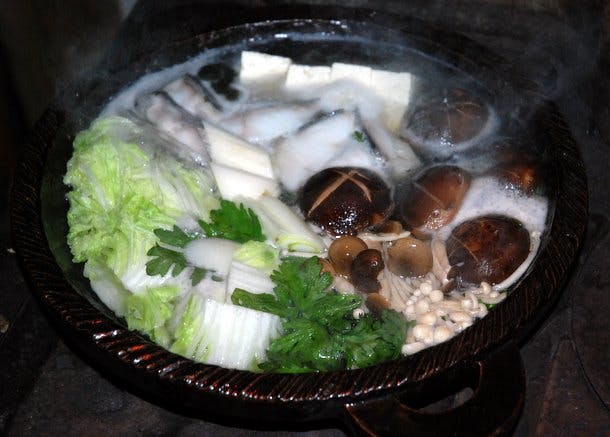
Freestyle Hotpot
Learn about the regional varieties of nabe (home-style hotpot cooking) in Japan, including Yose-nabe, the Tokyo-style 'anything goes' hotpot. The article also contains a kitchen recipe for preparing Yose-nabe, including a list of typical hotpot ingredients and simple preparation steps.
After I wrote about home-style hotpot cooking I asked a friend in Japan to research the many regional varieties of this social and comforting soul food. She just sent me a list of twenty styles of nabe, dishes prepared with salmon, tuna, octopus, pork, chicken, root vegetables, even wild boar and snapping turtle. These hotpots all reflect local foods, customs and geography, and their histories and lore are absolutely fascinating: One traces back to the cooking of Japanese pirates, another originated with bear hunters. There's a nabe invented by sake makers living inside breweries during production season and one that's supposed to be eaten in the dark (yikes!). There's even a nabe invented in 2005 to commemorate the merger of three cities. Like I said, fascinating.
I'm going to cook through some of these cold weather dishes before winter's end and report back (fair warning to my friends). Here's the first, which hails from the Tokyo: Yose-nabe, which translates roughly into "anything goes hotpot" -- you cook it with ingredients in hand. I recently hauled my rustic earthenware donabe to a fittingly rustic cabin in the snowy woods of northwestern Connecticut to whip up this dish for a group of, um, obliging friends.
Here's my the list of ingredients. Not exactly "in hand," but typical winter hotpot ingredients. I'm writing the Japanese names to help you find these foods in Japanese supermarkets (like Sunrise Mart in New York):
-- konbu (dried kelp)
-- negi (Japanese leek)
-- shungiku (chrysanthemum leaves)
-- hakusai (Napa cabbage)
-- shiitake
-- shimeji mushrooms
-- enoki mushrooms
-- kuzukiri (arrowroot starch noodles)
-- "broiled" tofu (grilled on the outside for aesthetics)
-- daikon radish (for grating)
-- ponzu (citrus, soy sauce and vinegar based condiment. I recommend Igeta Yubikiri Konbu Ponzu, if you can find it -- nicely balanced)
-- eggs
-- steamed Japanese short-grain rice
To these basic hotpot ingredients, I added black cod and freshly shucked (by yours truly) oysters (a delicious combination suggested by a Tokyo native). This nabe is considered "Tokyo-style" (or Kanto-style, the area which includes Tokyo), because of the first ingredient -- the broth here is konbu-based, rather than on miso-based. I'm told that's the way they traditionally roll in Tokyo, nabe-wise. If you can help me understand why, please comment or email me!
Notice that I didn't list quantities. Since this hotpot is "anything goes" you can adjust the proportion and type of ingredients to your liking (substitute the black cod for another fish, if you'd like, etc.). Just make sure to have enough food to stuff your guests into a blissful stupor, which seems to be the tradition everywhere I've been invited to hotpot dinner across Japan!
(For an idea of proportions, see my post on Hiroshima-style hotpot. Please scroll to the bottom.)
Preparation is very simple: About two hours before dinner, soak two 2-inch pieces of konbu in a stockpot-full of cold water. About an hour before dinner, prepare the rice and soak the kuzukiri noodles in a bowl of cold water. Now grate the daikon radish (called daikon oroshi), cut all the ingredients into bite-size pieces and artfully arrange on serving plates. Just before dinner, bring the stockpot with the konbu to a simmer -- but don't boil.
To serve: Place the donabe on a portable burner on the dining table, surrounded by plates of ingredients. Gather your guests around. Arrange the first round of ingredients in the donabe, except for the oysters, fill with the konbu broth (dashi), cover and bring to a boil. Once boiling remove cover and add the oysters to cook for 30 seconds or so. Serve in bowls, topped with daikon oroshi and a hit of ponzu. Eat. Repeat. Wash down with sake and beer.
When the ingredients have happily disappeared, add steamed rice to the remaining broth, swirl in a couple of raw eggs, cook for a minute, and serve. Add a little salt or soy sauce to taste. A satisfying finish to a satisfying meal. Just ask my friends.
